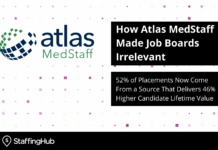
Key takeaways:
- Career growth — not just pay — is still the #1 preventable reason employees quit. In 2024 data, a lack of growth opportunities drove 18.9% of departures, ahead of work‑life balance and manager issues.
- Recruiter workload and stress are real. Over half of TA pros report the job is more stressful than a year ago; teams that lean on automation and AI reclaim time and reduce burnout.
- Loyalty is powered by growth, flexibility, great tools, and recognition. Clear career paths and continuous development are among the strongest retention levers; flexible work and removing rote tasks also matter.
Why top recruiters leave
The reasons your stars walk are predictable — and preventable:
- Stalled growth and unclear paths. A lack of career development tops the list of preventable quit reasons (18.9%), outpacing work‑life balance (11.9%) and management behavior (9.7%). If your best recruiters can’t see an upward or outward path, they’ll find one somewhere else.
- Chronic stress and admin overload. More than half (54%) of recruiting professionals say the job feels more stressful now than last year. Much of that stress traces back to high requisition loads and repetitive tasks that shouldn’t require human time.
- Tools and time to do the work. High‑performing firms that automate key steps see 39% more submissions per head and 22% more jobs filled — meaning tech reduces the grind that pushes recruiters out.
- Flexibility expectations. Flexible work remains one of the most influential topics shaping recruiting; teams increasingly advocate for flex policies, which in turn influence retention inside recruitment teams.
In short, if you don’t provide visible growth, reduce time‑wasters, and offer flexibility, your best people will burn out or disengage — long before they resign.
Red flags your best recruiters are considering leaving
Use this early‑warning checklist and trigger a stay conversation (and fixes) when 2-3 appear:
- Growth stall: No movement on career matrix in 9-12 months; fewer applications for level‑up projects.
- Quality drift: Declining 90‑day stick rate or hiring‑manager customer satisfaction score (CSAT) despite steady activity.
- Pipeline disengagement: ~20% drop in new candidates added or outreach volume for >4 weeks.
- Avoidance behaviors: Skipping deal reviews, turning down stretch requisitions, or resisting new tools and training.
- Time stress signals: Rising after‑hours activity, falling PTO usage, or frequent “heads‑down” isolation (burnout risk).
- Manager mismatch: Increased escalations or feedback that stalls — remember manager behavior is a top preventable quit driver.
What actually drives recruiter loyalty
- Progress they can see. SHRM highlights that opportunities for growth are a leading factor in whether employees stay — with clear paths improving retention and overall well‑being. For recruiters, “progress” often means bigger books, deeper niche authority, and higher‑margin work — not only titles.
- Time for high‑value work. LinkedIn’s 2024 data shows the top practical benefits recruiters get from GenAI are removing mundane tasks and making work more fulfilling — direct hits on two turnover drivers.
- Flexibility and autonomy. Flexible work continues to shape the function; giving senior recruiters autonomy over schedule, territory, and book composition translates into loyalty.
- Recognition that maps to impact. Top performers respond to recognition tied to quality (e.g., quality‑of‑hire, redeployments, candidate NPS), not just volume metrics. High‑performing agencies are notably more likely to “think creatively about incentives.”
- Continuous learning with L&D partnership. The share of recruiting pros who say TA and L&D must work more closely climbed to 85% — because upskilling on AI, data, and niche market knowledge keeps recruiters relevant and engaged.
Create advancement opportunities beyond traditional promotions
Great recruiters don’t all want to manage people. Build dual tracks with clearly priced competencies, pay bands, and milestone perks.
Expert / individual‑contributor track (examples)
- Principal recruiter (IC‑4): Owns a high‑value vertical; sets pricing strategy; mentors as a sponsor, not a manager; eligible for premium margin share.
- Practice builder (IC‑5): Launches new micro‑practices; carries revenue and GP targets; receives business‑builder sales performance incentive funds (SPIFs) on new logos and recurring GP.
- Strategic accounts closer: Partners with sales; comp tied to multi‑seat, multi‑site wins and redeployment rates.
Leadership / enablement track (examples)
- Team lead (M‑1): Small pod leadership, pipeline coaching, weekly deal review cadence.
- Recruiting enablement lead: Owns playbooks, interviewer training, and AI usage standards; measured on time‑to‑submit, submittal‑to‑interview, and cycle‑time reductions.
- Head of talent communities: Builds alumni/candidate communities; targets redeployment and candidate NPS.
How to roll it out (fast):
- Map 5-7 levels per track with competencies (e.g., market mastery, data fluency, client influence, coaching).
- Publish transparent pay bands and step‑ups (e.g., +X% base or +Y bps GM share per level).
- Offer micro‑badges (AI sourcing, negotiation mastery, clinical credentialing, etc.) that unlock tools and requisitions.
- Tie every step to a visible scorecard (see “Recognition” below).
Recognition and feedback systems that resonate with high‑performing recruiters
Move beyond “Top Biller of the Month.” Calibrate recognition to the outcomes your best people already optimize:
- Balanced scorecards: Weight 40% gross margin, 30% quality (quality‑of‑hire, 90‑day retention, hiring manager CSAT), 20% pipeline health (new prospects, submittal‑to‑interview), 10% community (mentoring, content, referrals).
- Win stories > leaderboards: Run a 15‑minute weekly “deal dissection” where a top recruiter presents how they won — objection handling, sourcing path, and value narrative.
- Quality awards: Quarterly awards for 90‑day stick rate, redeployments, and candidate NPS keep focus on durable value, not just volume.
- Creative incentives: High‑performers respond to tailored perks — budget for market events, research subscriptions, personal sourcer credits, AI tooling add‑ons — mirroring what top‑performer agencies already do.
- Close the loop on feedback: Exit and stay interviews predict attrition risk when you act on them. The Work Institute finds organizations that use these insights reduce preventable turnover. Make action follow‑ups visible to staff.
Build a culture of professional development and continuous learning
- Institutionalize learning time. Budget one hour per week for skill drills (e.g., search strings, negotiation roleplays, AI prompts for outreach).
- Teach “AI for recruiters.” LinkedIn’s data shows the biggest payoffs are removing mundane tasks and improving productivity; SHRM recommends using AI to reduce repetitive work. Pair training with clear usage policies.
- TA × L&D “squad.” With 85% of professionals calling for closer TA-L&D collaboration, appoint a joint squad to own skills matrices, micro‑credentials, and rotations.
- Make thought leadership part of the job. Publish quarterly market briefs; pay stipends for conference talks and original research (e.g., salary guides, niche skill maps).
- Level‑up with automation. High‑performing firms automate intake, screening, and onboarding, translating into faster placements and less burnout time.
30‑60‑90 day retention sprint
Days 1-30: Diagnose and stabilize
- Run stay interviews with your top 20% (ask: “Which deals energize you? What should we stop doing?”). Publish 3-5 “we heard you” actions.
- Remove 2+ rote tasks via automation (e.g., scheduling, credential chasers). Train teams on approved AI use.
- Launch transparent career architecture (e.g., dual tracks, levels, scorecards, bands).
Days 31-60: Reward the right behaviors
- Roll out the balanced scorecard and convert monthly recognition to quality‑weighted awards.
- Create micro‑badges (e.g., AI sourcing, outreach personalization, market mapping) that unlock high‑value requisitions and bonuses.
- Stand up a TA×L&D skills squad; announce quarterly upskilling goals.
Days 61-90: Lock in loyalty
- Implement mentor–sponsor pairs for every senior IC; tie sponsorship to leader goals.
- Publish a learning calendar (weekly drills + monthly masterclass).
- Share quarterly retention dashboard: senior‑IC retention %, redeployment rate, 90‑day stick rate, and manager eNPS.
KPI set to prove it’s working
- Senior‑IC retention % (rolling 12 months)
- Time‑to‑submit and submittal‑to‑interview (automation ROI)
- 90‑day stick rate / quality‑of‑hire
- Redeployment rate (contract)
- Candidate NPS and hiring manager CSAT
- Learning velocity: badges earned per recruiter; % completing AI training
FAQ for staffing agency leaders
Q: What are the top preventable reasons employees quit?
A: According to 2024 exit-interview data, the leading driver is career development (18.9%), followed by work-life balance (11.9%) and management behavior (9.7%). This underscores the need for visible growth paths and supportive leadership.
Q: How stressed are recruiters today — and is AI helping?
A: More than half (54%) of recruiters say their jobs are more stressful than a year ago. However, 63% now use AI in recruiting, which has helped cut average time-to-fill by 7 days. AI reduces repetitive tasks, freeing recruiters for more impactful work.
Q: What impact does automation have on staffing firm performance?
A: Agencies that have implemented automation see a 39% increase in submissions per recruiter and a 22% lift in jobs filled. High-performing staffing firms are the most aggressive adopters of automation.
Q: How does professional development affect recruiter retention?
A: Employees with clear growth paths are significantly more likely to stay. In fact, 85% of recruiting professionals now say talent acquisition and L&D must work more closely — reflecting the importance of upskilling in AI, data, and niche expertise.
Retaining elite recruiters isn’t a mystery. Make progress visible, free them from drudgery, reward durable value, and keep them learning. Do that, and your best people won’t be looking for a way out — they’ll be building the next record quarter with you.





